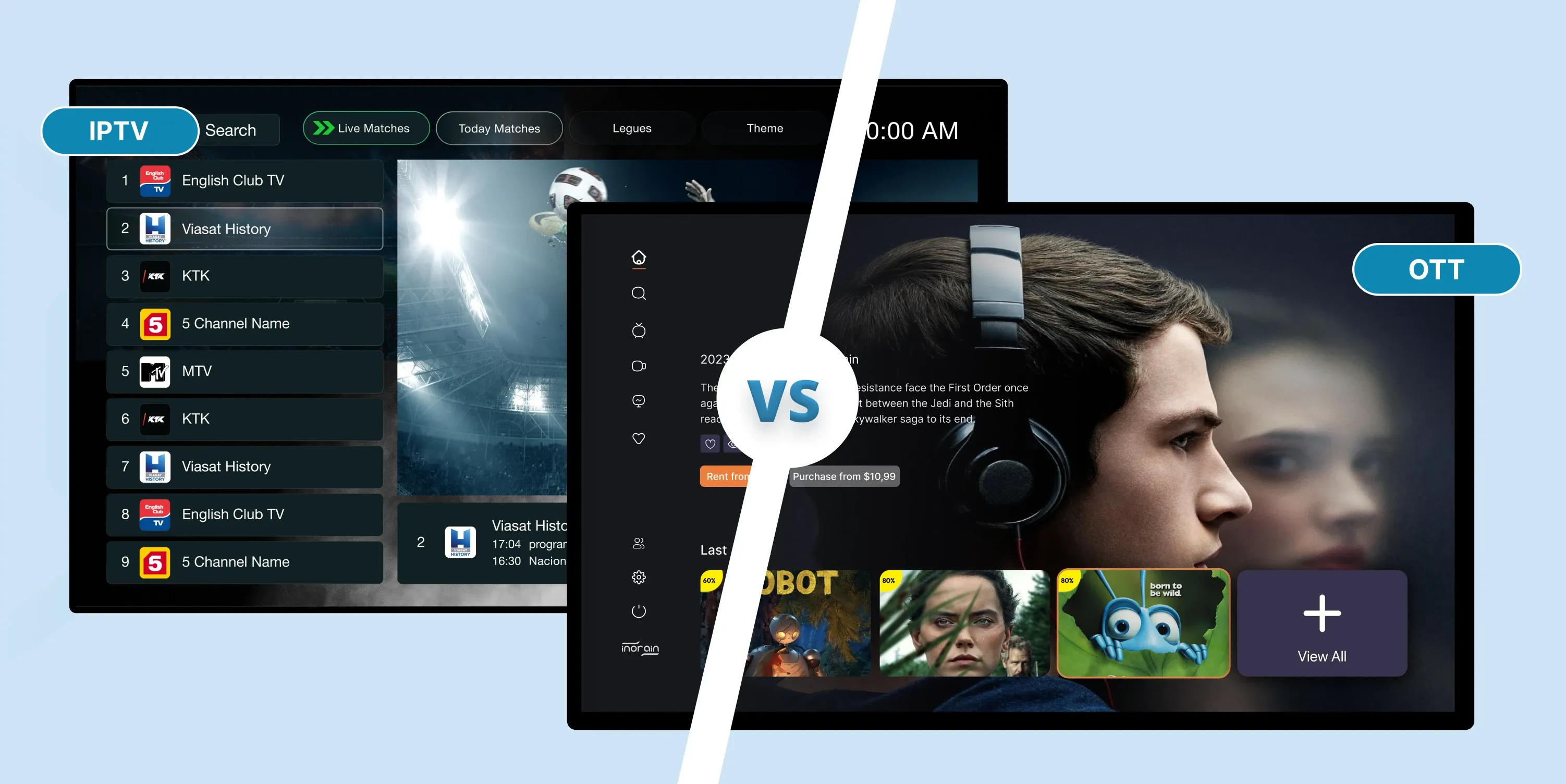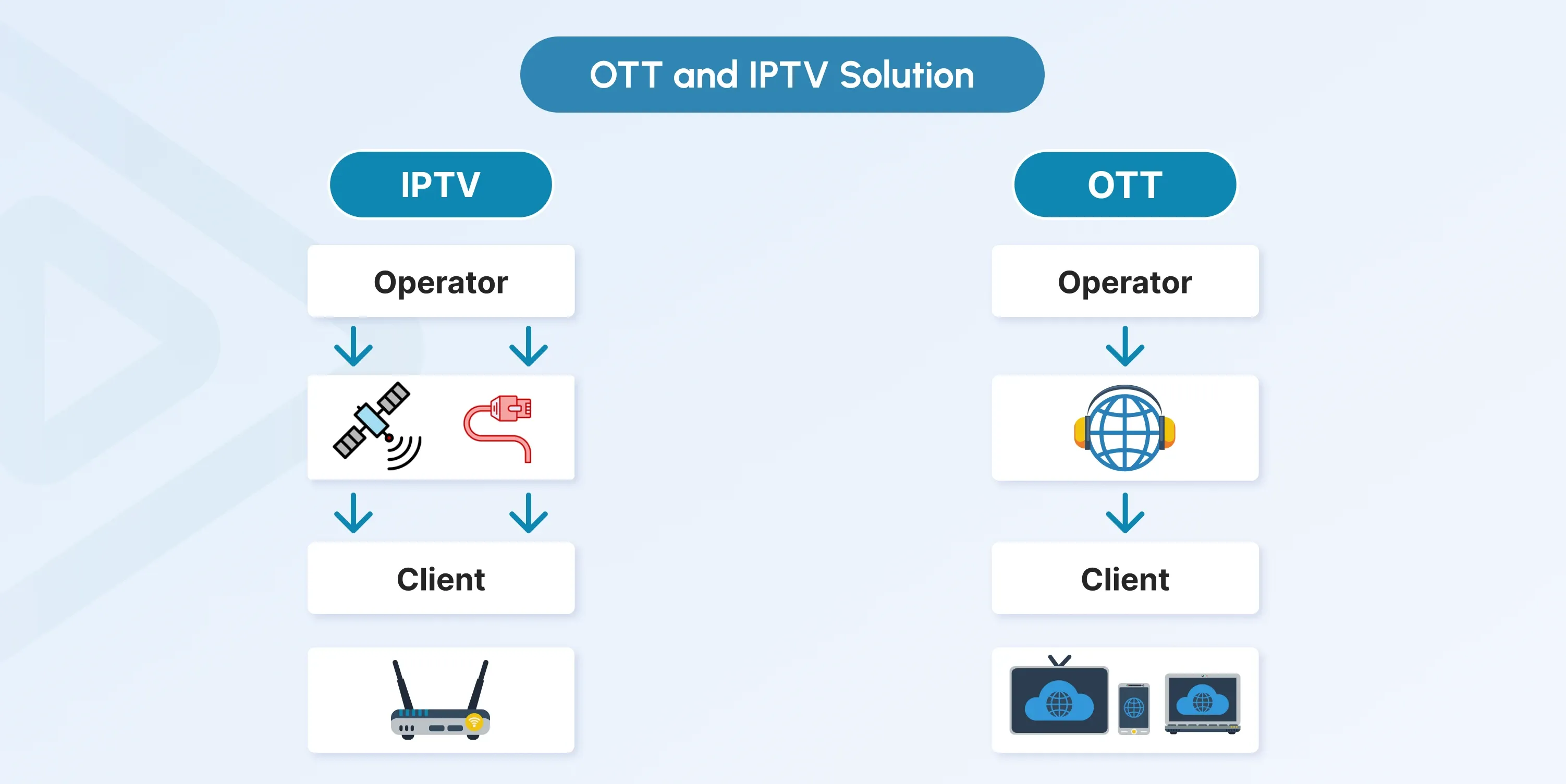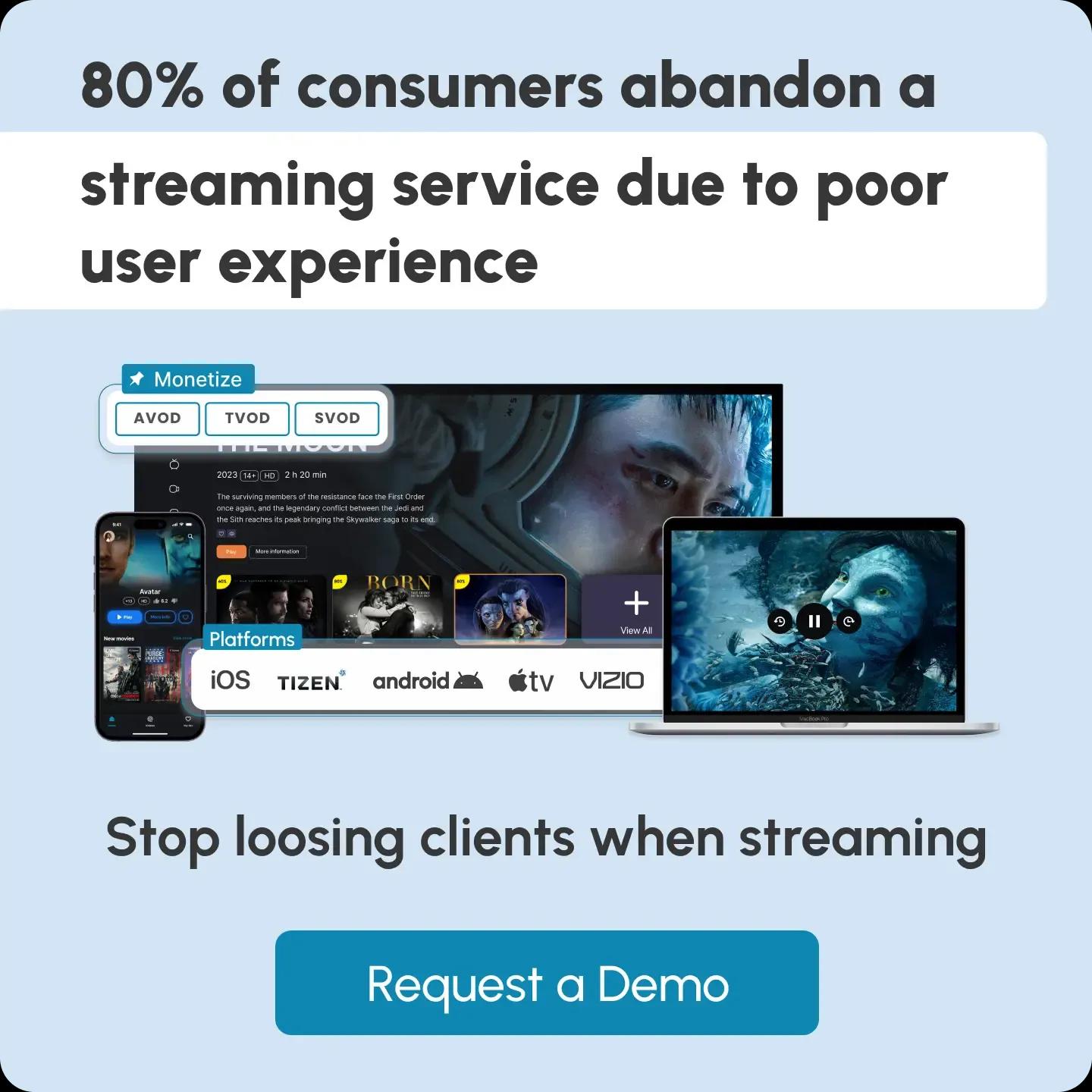
IPTV vs OTT: Key Differences and How to Choose
What is the difference between IPTV and OTT? While both are popular media streaming models, which one do you need for your streaming business?
IPTV (Internet Protocol Television) streams traditional television content via private networks, often requiring a set-top box and a stable internet connection. On the other hand, OTT (Over-the-Top) bypasses traditional TV methods, allowing users to stream content,like series and movies, directly over the internet without the need for a set-top box or private network.
IPTV vs. OTT comparisons can help you determine the best fit for your content distribution needs. This article will explore the differences between these two popular models to better understand their unique advantages.

Key Takeaways
- Unlike IPTV, OTT allows content to be broadcast across a wide range of devices without the need for a set-top box.
- OTT platforms help businesses expand their global audience by delivering content without the geographical constraints of traditional television.
- Through targeted advertising based on viewer behavior, OTT platforms boost engagement and increase ad effectiveness.
- OTT enhances the user experience by providing on-demand content, allowing viewers to stream whenever and wherever they choose.
- While OTT uses a cloud-based structure that scales with demand, IPTV technology offers scalable solutions for expanding content delivery.
What is OTT?
OTT, or "Over-the-Top," refers to media services that stream content directly to consumers via the Internet. This modern approach bypasses traditional broadcast, cable, or satellite networks, giving viewers more control over how and when they consume content.
With OTT, viewers can enjoy content on various devices, from smartphones to computers, making it highly flexible and accessible. Additionally, OTT content delivery offers multiple subscription models or ad-supported free versions, making it a versatile solution for a broad audience.
5 Benefits of OTT
Let's examine the five main benefits OTT offers.
1. Accessibility and Convenience
OTT platforms allow users to stream content anytime, anywhere, as long as they have an internet connection. Viewers can enjoy on-demand access, whether on smartphones, tablets, smart TVs, or computers, giving them full control over their viewing experience.
2. Enhanced Customer Engagement
OTT services’ availability across multiple devices helps businesses reach a broader audience, increasing customer engagement. Viewers can enjoy content at their own pace, making binge-watching and flexible viewing more appealing. Personalized recommendations further enhance engagement by curating content based on user behavior and preferences.
3. Flexible Pricing Models
OTT platforms offer multiple monetization options for you to choose from depending on your target audience and business goals:
- Subscription-based Video on Demand (SVOD): Users pay a recurring fee for unlimited access to content.
- Ad-supported Video on Demand (AVOD): Content is free but supported by advertisements.
- Transactional Video on Demand (TVOD): Viewers pay per movie or episode without long-term commitments.
4. Personalization and Content Recommendations
Compared to IPTV, OTT platforms use sophisticated algorithms to analyze user behavior and deliver personalized recommendations. This improves user satisfaction by ensuring they discover relevant content, fostering deeper connections, and increasing platform loyalty.
5. Advanced Data Analytics and Targeted Advertising
You can benefit from OTT’s data-driven approach, as platforms collect valuable insights on user behavior, preferences, and location. This enables highly targeted advertising, allowing advertisers to precisely reach specific audience segments. As a result, you can optimize your marketing strategies and maximize revenue opportunities.
OTT Challenges and Solutions
Bandwidth and Streaming Quality
OTT relies on the public internet, making it susceptible to buffering, lag, and quality drops, especially in regions with slow connections.
Solution: Implement adaptive bitrate streaming (ABS) to adjust video quality dynamically based on internet speed. Use Content Delivery Networks (CDNs) to ensure smooth streaming and reduce latency.
Content Piracy and Security
Unauthorized distribution, illegal downloads, and account sharing can lead to revenue loss and data breaches.
Solution: Protect content using Digital Rights Management (DRM), watermarking, and encryption techniques. Implement multi-factor authentication to prevent unauthorized access.
User Retention and Engagement
High churn rates occur as users frequently switch between platforms, leading to unstable revenue.
Solution: Use AI-driven personalized recommendations and interactive content. To engage users, offer loyalty programs, exclusive content, and flexible subscription plans.
Regulatory and Compliance Issues
OTT platforms must comply with regional regulations regarding data privacy, licensing, and content censorship.
Solution: Stay updated on global and regional content regulations. Implement robust compliance policies and use geo-blocking where necessary to adhere to licensing agreements.
What is IPTV?
IPTV stands for Internet Protocol Television, a service that provides consumers access to television content over the Internet. Unlike traditional TV, which relies on cable or satellite signals, IPTV transmits movies and TV shows directly over a private IP network and broadband connection. This means users can access IPTV services with a reliable internet connection from an ISP (Internet Service Provider).
With IPTV technology, viewers can access various channels and on-demand content on multiple devices, including TVs, PCs, tablets, and smartphones. This service typically offers live TV and time-shifted content, allowing users to watch previously aired programs at their convenience and video-on-demand (VOD) options, similar to popular streaming services.
IPTV frees users from traditional TV schedules, enabling them to enjoy their favorite shows more conveniently and flexibly. In addition, IPTV provides stable, high-quality streaming via high-speed internet and often includes interactive features that enhance the viewing experience.
5 Benefits of IPTV
Here are the five key advantages of IPTV:
1. Personalized Content Delivery
IPTV enables you to provide customized content packages tailored to specific audiences. Industries such as hospitality, healthcare, and education can offer curated programming that meets their clients' unique needs. This personalization enhances customer satisfaction and engagement by delivering relevant and valuable content.
2. Stable and High-Quality Streaming
Unlike OTT, which relies on the public internet and can experience buffering or quality drops, IPTV operates over a dedicated, secure network. This ensures a stable, high-quality streaming experience with minimal interruptions.
3. Multiple Monetization Options
IPTV supports various revenue models, including:
- Pay-per-view (PPV): Viewers pay for specific content, such as live events or premium programming.
- Subscription-based models: Regular fees provide continuous access to exclusive channels or content.
- Targeted advertising: Businesses can run ads based on viewer preferences, increasing advertising effectiveness and revenue.
4. Enhanced Security and Data Protection
Operating on a controlled network environment, IPTV offers greater security than OTT platforms. Businesses handling sensitive data—such as healthcare providers or corporate enterprises—benefit from encryption and access control features that prevent unauthorized viewing and data breaches.
5. Scalability and Cost Efficiency
IPTV infrastructure is highly scalable, allowing businesses to expand services as demand grows. The network can handle increased traffic without compromising quality by adding more users or introducing new channels. Additionally, IPTV leverages existing IP networks, reducing infrastructure costs while maintaining high service standards.
IPTV Challenges and Solutions
High Infrastructure and Maintenance Costs
IPTV requires a dedicated network, expensive hardware, and ongoing maintenance, making it costly for providers.
Solution: Optimize your IPTV infrastructure by using cloud-based IPTV solutions. Partner with third-party CDN providers to reduce in-house costs.
Network Congestion and Bandwidth Limitations
IPTV relies on a closed network, which can experience congestion, leading to buffering and degraded service quality.
Solution: Implement network load balancing and Quality of Service (QoS) measures to prioritize IPTV traffic and ensure smooth delivery.
Regulatory and Licensing Challenges
IPTV providers must comply with strict content licensing agreements and telecom regulations, which vary by region.
Solution: Work with legal experts to ensure local and international regulations compliance. Use geo-blocking and content restriction measures where required.
Key Differences Between IPTV and OTT
Here is a table showing the key differences between IPTV and OTT services
| IPTV (Internet Protocol Television) | OTT (Over-the-Top Streaming) | |
|---|---|---|
| Network Type | Uses a closed, proprietary, high-bandwidth network through a designated ISP. | Uses an open network (public internet) with no required infrastructure investment. |
| Infrastructure and Setup | More costly and complex to install, run, and update but offers high reliability and quality. | Easier and cheaper to set up; quality depends on internet speed and device performance. |
| Required Components | Needs an internet connection, router, and set-top box or IP-enabled TV. | Requires a solid internet connection, a compatible streaming device (smart TV, smartphone, tablet, or streaming media player), and access to an OTT app. |
| Subscription and Pricing | Generally priced similarly to conventional cable or satellite TV. | Can range from free (AVOD model) to low-cost subscriptions, starting as low as $4.99/month. |
| Advertising Model | Uses traditional TV-style ads embedded within scheduled programming. Limited personalization. | Uses dynamic, personalized ads based on viewer behavior, location, and preferences. |
| Ad Placement | Ads are placed within program segments, similar to traditional TV. | Ads can be pre-roll, mid-roll, or post-roll, making them more flexible and targeted. |
| Ad Targeting | Focuses on program/channel demographics, with some addressable advertising but limited personalization. | Uses advanced data analytics for precise ad targeting, delivering relevant and interactive ads. |
| Quality and Stability | High-quality, stable streaming due to controlled bandwidth and dedicated infrastructure. | Quality varies based on internet speed, device, and network congestion. |
| Scalability and Expansion | Scalable within a controlled environment but requires infrastructure investment. | Highly scalable with minimal infrastructure costs. |
| Monetization Options | Subscription-based, pay-per-view, and traditional TV advertising. | Subscription-based (SVOD), ad-supported (AVOD), and pay-per-view (TVOD) models. |
Choosing the Right Platform: IPTV vs. OTT
Deciding between IPTV and OTT depends on your business goals and the preferences of your target audience.
If your company values controlled, premium content delivery similar to traditional TV, IPTV is an ideal choice. IPTV ensures uninterrupted streaming via a secure network, making it well-suited for sectors like hospitality and healthcare, where tailored content packages and a consistent viewing experience are key.
On the other hand, OTT offers a more flexible, modern approach to content distribution. OTT platforms are better suited if your audience prefers on-demand access and personalized viewing. OTT allows content delivery across multiple devices, reaching a tech-savvy, global audience. With advanced analytics and dynamic ad targeting, OTT makes it easier to monetize content through highly targeted ads, boosting engagement and revenue.
Moreover, OTT’s global reach opens up new business markets, increasing visibility and growth potential.
 Ultimately, the decision between OTT vs. IPTV depends on your content delivery goals, audience engagement strategies, and revenue objectives.
Ultimately, the decision between OTT vs. IPTV depends on your content delivery goals, audience engagement strategies, and revenue objectives.
IPTV offers regulated, consistent content delivery, while OTT provides flexibility, customization, and access to valuable user data. Understanding the strengths of each platform will help you make informed decisions aligned with your business strategy.
Choose inoRain for Your OTT Business Needs
If you choose OTT services for your streaming business, don’t go far; we have everything for your OTT business needs!
inoRain delivers OTT solutions to help you thrive in digital streaming.
Specializing in web and mobile development, inoRain’s software transforms your business into a fully operational OTT platform.
Trusted by over 50 companies globally, inoRain helps businesses expand their audience and increase revenue through secure, high-quality streaming services.
Here’s what inoRain offers for your OTT business growth:
- Flexible Monetization: Choose from various monetization models, including AVOD (Advertising-based Video on Demand), TVOD (Transactional Video on Demand), and SVOD (Subscription Video on Demand), allowing you to maximize revenue in a way that best fits your business model.
- User-Friendly Dashboard: Manage your streaming services from a single dashboard with real-time analytics, ensuring streamlined operations.
- Cross-Platform Streaming: inoRain’s solutions are available on over 20 platforms, ensuring your content is accessible across devices such as smart TVs, mobile phones, and browsers.
- High-Quality Streaming: inoRain provides adaptive multi-bitrate streaming, guaranteeing high-quality video with minimal buffering.
- VOD and Live TV Integration: Offer a seamless interface for both video-on-demand and live TV channels, providing your viewers with flexible content consumption options.
- Security and DRM: Protect your content with robust multi-DRM technology, ensuring your media is secure from piracy and unauthorized access.
- 24/7 Support: inoRain offers round-the-clock customer support to ensure your business runs smoothly across time zones.
Partner with inoRain to effortlessly manage content, reach larger audiences, and boost revenue. Contact us to learn more.
Conclusion
While OTT and IPTV offer distinct advantages, both can play a pivotal role in growing your business.
IPTV provides a more controlled, secure environment for content distribution, similar to traditional TV, making it ideal for businesses prioritizing stability and data protection.
In contrast, OTT delivers more freedom, personalization, and greater reach, allowing you to connect with modern audiences across multiple platforms.
Understanding each platform's strengths and limitations will help you decide which option—or a combination of both—best aligns with your business goals.
FAQs
What is OTT?
OTT (Over-the-Top) means delivering video, audio, and other media content over the Internet without relying on traditional cable or satellite TV providers. Examples include Netflix, YouTube, and Disney+.
What is IPTV?
IPTV (Internet Protocol Television) is a technology that delivers TV content over a private, dedicated internet network instead of traditional cable or satellite. It provides live TV, on-demand videos, and interactive features, and it is often used by telecom providers and businesses.
Can I use both OTT and IPTV for my advertising campaigns?
Yes, you can run your ads on both systems. OTT makes dynamic and customized ad placements easier, while IPTV offers more conventional advertising models. Combining the two could help you appeal to a wider audience with different watching tastes.
How safe is IPTV?
IPTV guarantees a great degree of security while operating on a closed, safe network. For companies managing private or confidential data, this method offers better control over content distribution and protection against illegal access.
What are the key differences between IPTV vs. OTT?
The primary difference between IPTV and OTT lies in their delivery methods. IPTV streams content through a private, closed network, providing high reliability and security. In contrast, OTT delivers content over the public internet, allowing for greater flexibility and accessibility on various devices without needing a set-top box. OTT offers more dynamic ad targeting, while IPTV follows more traditional advertising models.
Co-founder / CTO
Armen is the CTO and Co-Founder of inoRain OTT and Co-Founder of HotelSmarters, specializing in advanced streaming technologies, OTT strategy, and interactive TV systems. He builds scalable end-to-end video delivery solutions and drives technical innovation across hospitality and streaming platforms, bridging complex engineering with practical business impact.

OTT Advertising: Types, Best Practices, and Strategies
Over-the-top (OTT) advertising has transformed how brands connect with consumers.

VPlayed Alternatives: inoRain vs. VPlayed
Explore inoRain as a VPlayed alternative, comparing features, pricing, and OTT solutions to find the best platform for your streaming needs.

Custom OTT Platform Development: How to Start an OTT Business
This guide will walk you through everything you need to know about the OTT platform development.
